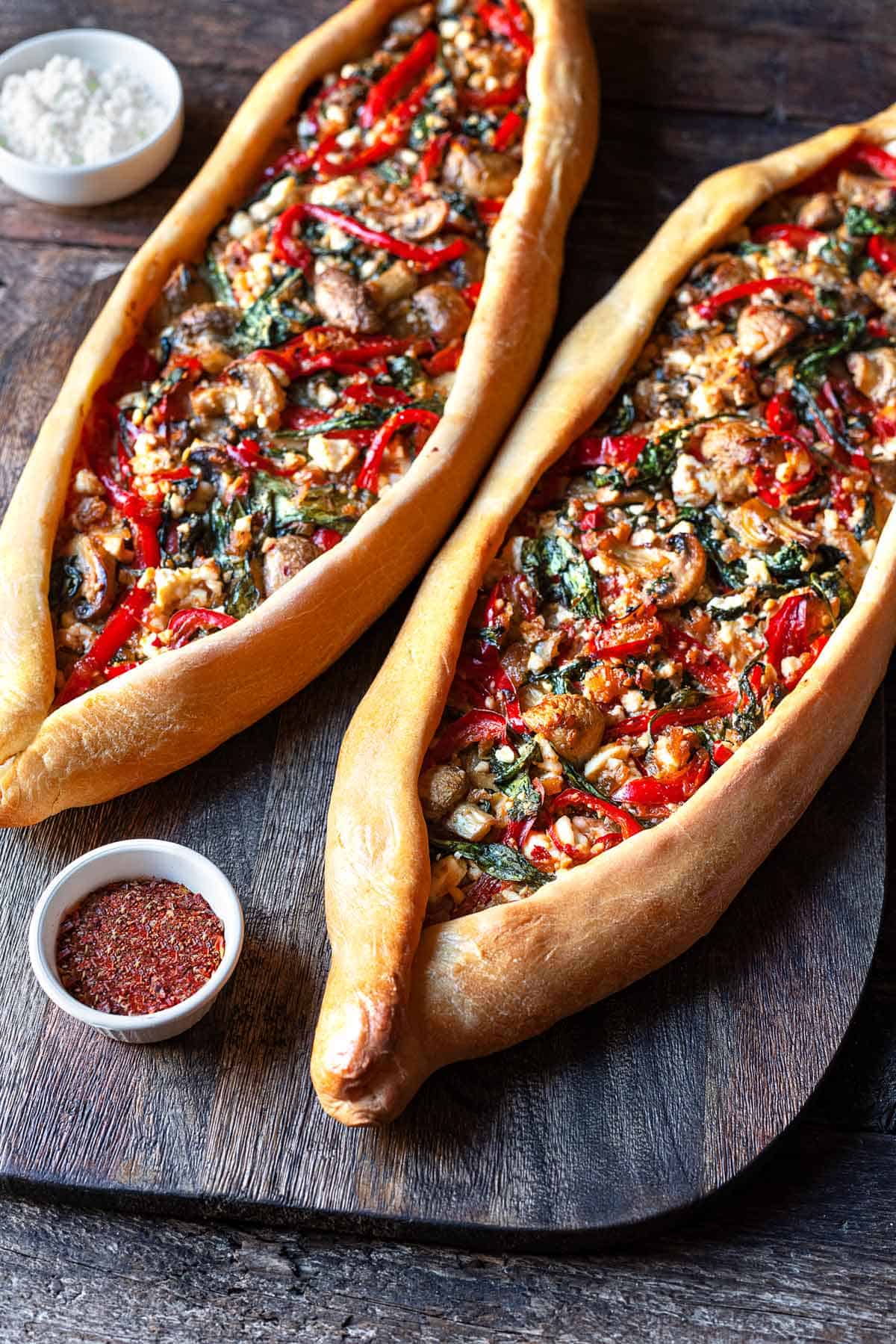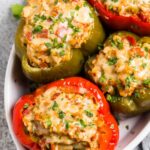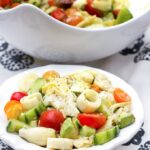Turkish cuisine is famous for its diverse flavors and rich culinary traditions, offering a unique blend of Middle Eastern, Mediterranean, and Central Asian influences. Why settle for mundane meals when you can explore the vibrant and distinctive taste of Turkish dishes right in your kitchen? From hearty stews to refreshing salads, every Turkish recipe promises to bring something special to your dining table.
Whether you’re an experienced cook or a beginner, Turkish recipes are accessible and enjoyable to make. Utilizing fresh, locally-sourced ingredients like vegetables, fruits, spices, and nuts, these recipes capture the essence of Turkey’s culinary heritage. Dive in and discover a world of flavors that are both familiar and exotic.
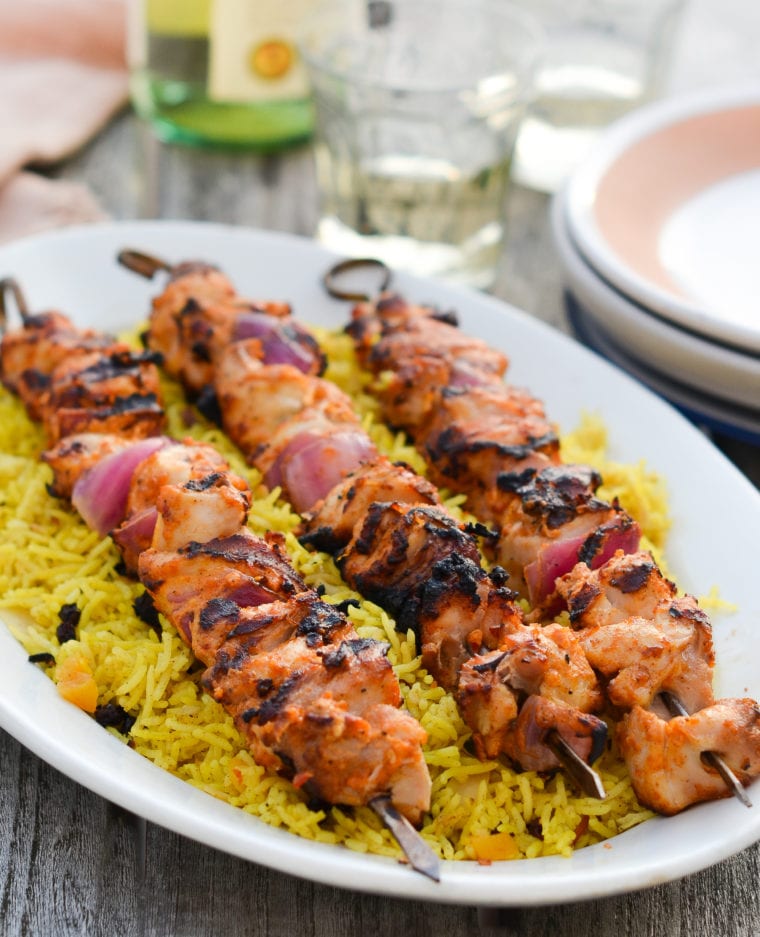
1) Kebabs
Turkish kebabs are a delicious and varied part of Turkish cuisine. They come in many different styles and flavors. An Adana kebab is made from ground lamb mixed with spices like cumin, sumac, and chili flakes. This mixture is kneaded until it becomes sticky and then grilled on skewers.
Another popular type is the Iskender kebab. It consists of thinly sliced lamb or beef served over pitta bread soaked in tomato sauce. The dish is topped with melted butter and a dollop of yogurt on the side.
The Manisa kebab is also noteworthy. Originating from Manisa, it features marinated lamb or beef pieces served over pitta bread with tomato sauce and melted butter. This kebab is rich in flavor and very satisfying.
The Çökertme kebab is served on a bed of thin fried potatoes and topped with garlic yogurt and tomato sauce. It’s seasoned with ground cumin, chili pepper, onion, and thyme, offering a mix of textures and flavors that’s hard to resist.
Each type of kebab offers a unique taste experience. Whether you’re a fan of spicy dishes or prefer something mild, there’s a Turkish kebab that’s sure to satisfy your cravings. Turkish kebabs are versatile and a must-try for anyone interested in authentic Turkish cuisine.
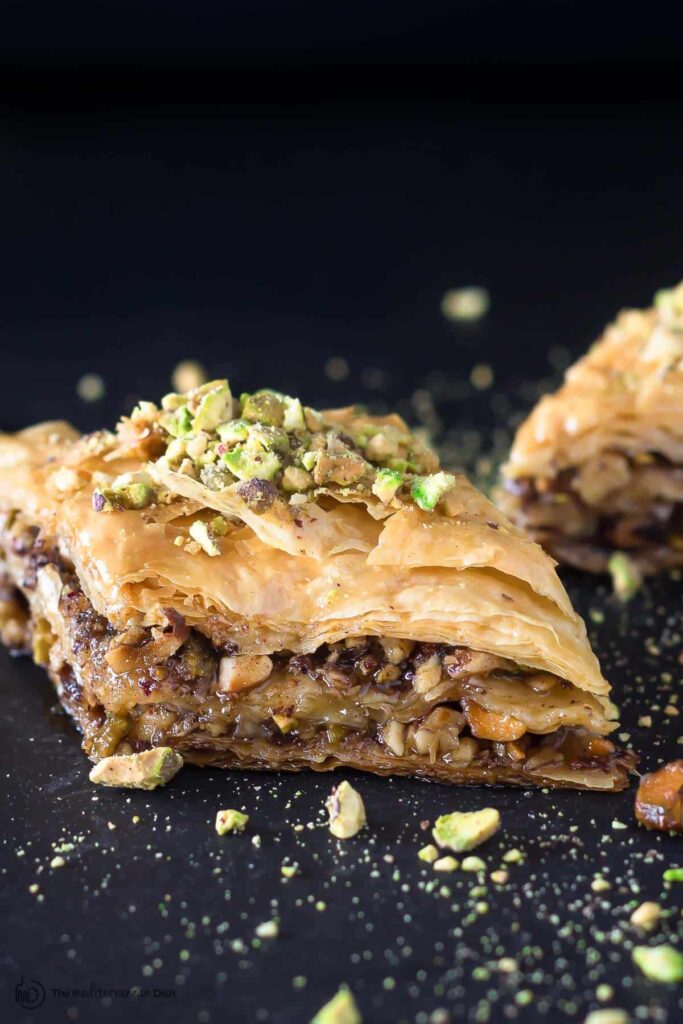
2) Baklava
Baklava is a famous Turkish dessert made with layers of thin, flaky pastry and filled with nuts. This sweet treat is a perfect blend of crunchy and gooey textures.
To make baklava, you’ll need phyllo dough, butter, nuts (usually pistachios or walnuts), sugar, and water. Start by trimming the phyllo dough to fit your baking dish and covering the dough with a damp towel to keep it from drying out.
Each layer of phyllo is brushed with melted butter and stacked. After several layers, sprinkle the chopped nuts evenly. Repeat the process until you’ve used all the phyllo and nuts.
Bake the layered pastry until it’s golden and crispy. While it bakes, prepare a syrup with sugar, water, and lemon juice. Let it boil for a few minutes and then cool down slightly.
As soon as the baklava is out of the oven, pour the warm syrup over it. The syrup soaks into the layers, giving baklava its signature sweetness and sticky texture. Let it cool completely before cutting it into squares or diamonds.
Baklava is deliciously sweet and perfect with a cup of Turkish tea or coffee. Enjoy every bite of this delightful dessert.
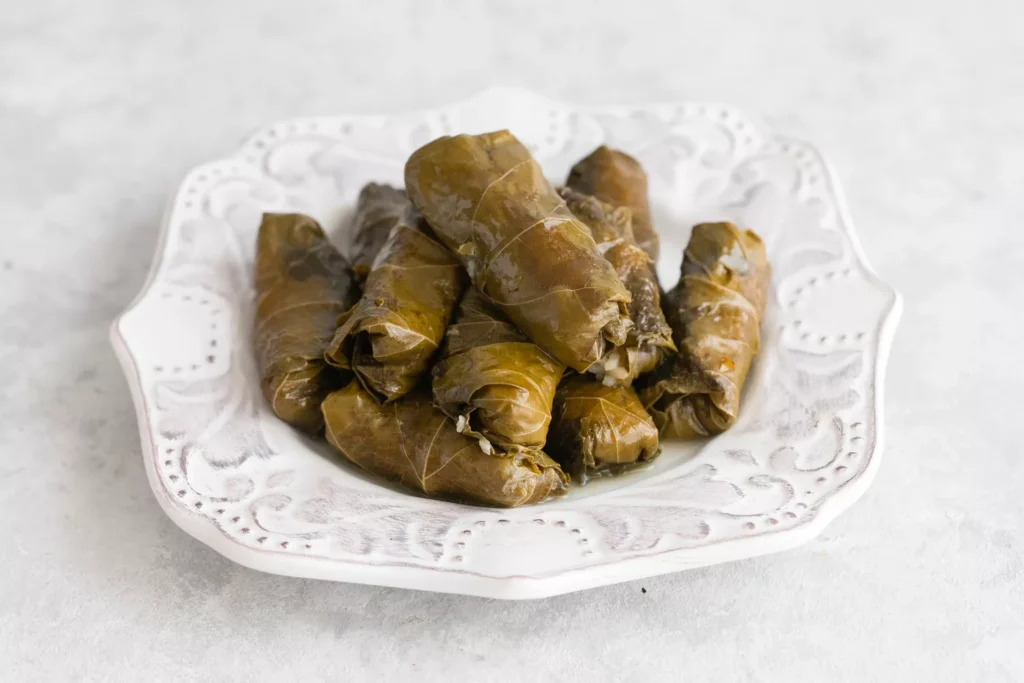
3) Dolma
Dolma is a popular Turkish dish featuring vegetables stuffed with a flavorful filling.
The filling often includes rice, onions, tomatoes, and fresh herbs like parsley, dill, and mint. Some versions add ground beef or lamb for extra richness. The rice is usually soaked first to ensure even cooking.
To prepare, you mix the filling ingredients in a bowl. Then, you stuff the vegetables, leaving some space at the top. This is important because the rice will expand as it cooks.
Vegetables commonly used for Dolma include grape leaves, bell peppers, zucchini, and eggplants. Grape leaves are used for a traditional version called Yaprak Sarma.
After stuffing, you arrange the Dolma in a pot. Pour hot water or broth over them until covered. Simmer for about 30 minutes until the rice is fully cooked and the flavors meld together.
Dolma can be served warm or cold, often with a drizzle of olive oil and a squeeze of lemon juice. The dish is a staple in Turkish cuisine and can be enjoyed as an appetizer or a main course.
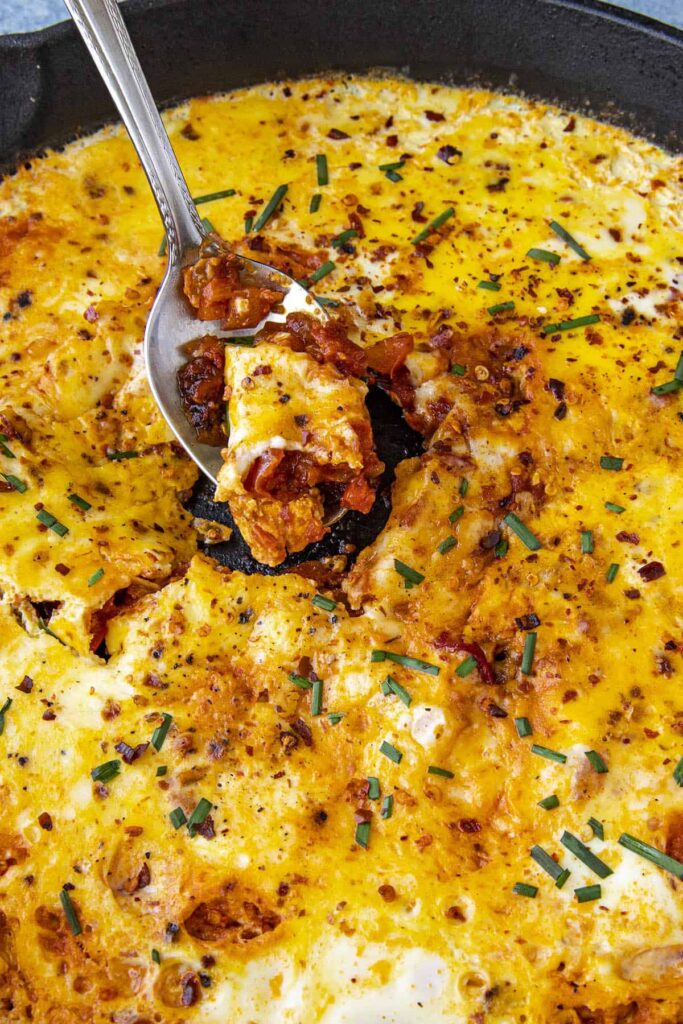
4) Menemen
Menemen is a popular Turkish dish made with eggs, tomatoes, peppers, and spices. It’s similar to scrambled eggs but with a lot more flavor and texture.
To make Menemen, you start by heating olive oil in a skillet. Add chopped onions and green peppers. Cook until they are soft and the onions become translucent.
Next, you add finely chopped or grated tomatoes to the pan. Cook them down until they form a thick sauce. This usually takes about 7 to 9 minutes.
After the tomatoes are cooked, reduce the heat. Push the tomato mixture to one side of the skillet. Beat the eggs and add them to the other side. Stir them gently until they are just set.
Once the eggs are set, fold the tomato mixture into the eggs. Season the dish with salt, pepper, and spices like oregano and paprika. Garnish with some fresh parsley if you like.
Menemen is often served hot with fresh bread. It makes for a hearty breakfast or a light meal at any time of the day.

5) Gözleme
Gözleme is a traditional Turkish flatbread that’s both delicious and versatile. You can fill it with various ingredients like spinach, cheese, potatoes, or meat. This makes it a flexible option for any meal.
To make the dough, you mix flour, oil, salt, and water until smooth. The dough needs to rest for about 20 minutes. This helps it become pliable and easier to roll out.
Once your dough is ready, roll it into a thin sheet. Place your chosen filling in the center of the dough. Fold the edges over to seal it completely.
Cook your Gözleme in a hot skillet, turning it frequently. This ensures that it cooks evenly and doesn’t burn. You want both sides to be a nice golden brown.
You can enjoy Gözleme hot from the skillet. Brush it with a little melted butter or olive oil for extra flavor.
This dish is perfect for breakfast, lunch, or a snack. The best part is, you can experiment with different fillings to suit your tastes.
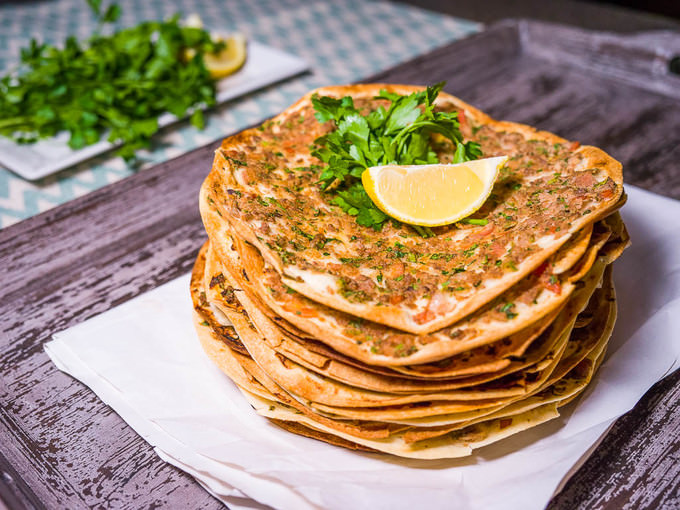
6) Lahmacun
Lahmacun, often called Turkish pizza, is a thin, round flatbread topped with minced meat. It’s popular in Turkey and neighboring countries. The word “lahmacun” comes from Arabic, meaning “meat with dough.”
To make lahmacun, you’ll need a simple dough. Start with flour, water, salt, and yeast. Knead until smooth and let it rest until it doubles in size.
For the topping, use minced lamb or beef mixed with finely chopped vegetables like peppers, onions, and tomatoes. Add parsley, garlic, and spices like paprika and cumin for extra flavor.
Once the dough has risen, roll it out into thin circles. Spread the meat mixture evenly across each piece, leaving a small border around the edges.
Bake in a preheated oven, usually around 450°F (230°C), for about 7 minutes. The edges should be crispy, and the topping should be cooked through.
Serve your lahmacun with fresh lemon wedges and a side of salad. Many enjoy rolling the lahmacun around some veggies like lettuce, tomatoes, and onions for added crunch.
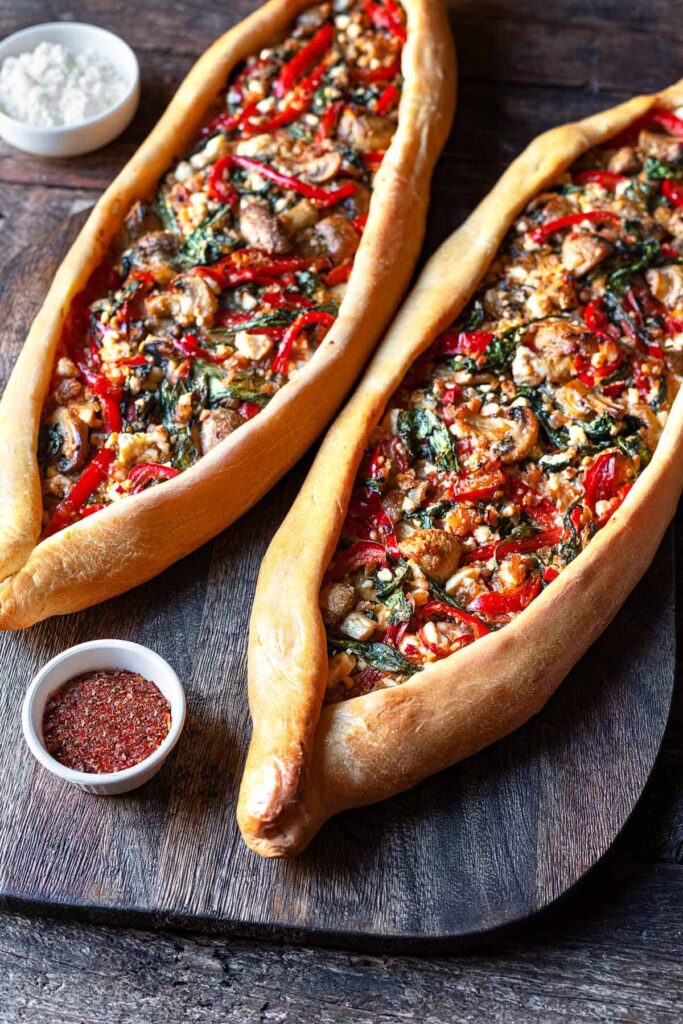
7) Pide
Pide is a traditional Turkish flatbread often compared to pizza. Its unique boat shape and variety of toppings make it a versatile dish. The dough is soft and chewy, providing the perfect base for various fillings.
To make the dough, you start with simple ingredients like lukewarm water, yeast, and sugar. Combine these with flour and knead until the dough is smooth and elastic. Let it rise, then divide it into portions.
Popular fillings for Pide include cheese, spinach, Turkish sausage, and spiced lamb. You can also opt for ground beef mixed with onions and spices. Spread your chosen filling over the dough, leaving a small border. Fold the edges to create the signature boat shape.
Bake the Pide in a preheated oven until the dough is golden and the filling is cooked. Serve warm, often garnished with fresh herbs. This dish is a favorite in Turkish cuisine for its rich flavors and satisfying texture. Enjoy it as a main course or a hearty snack.
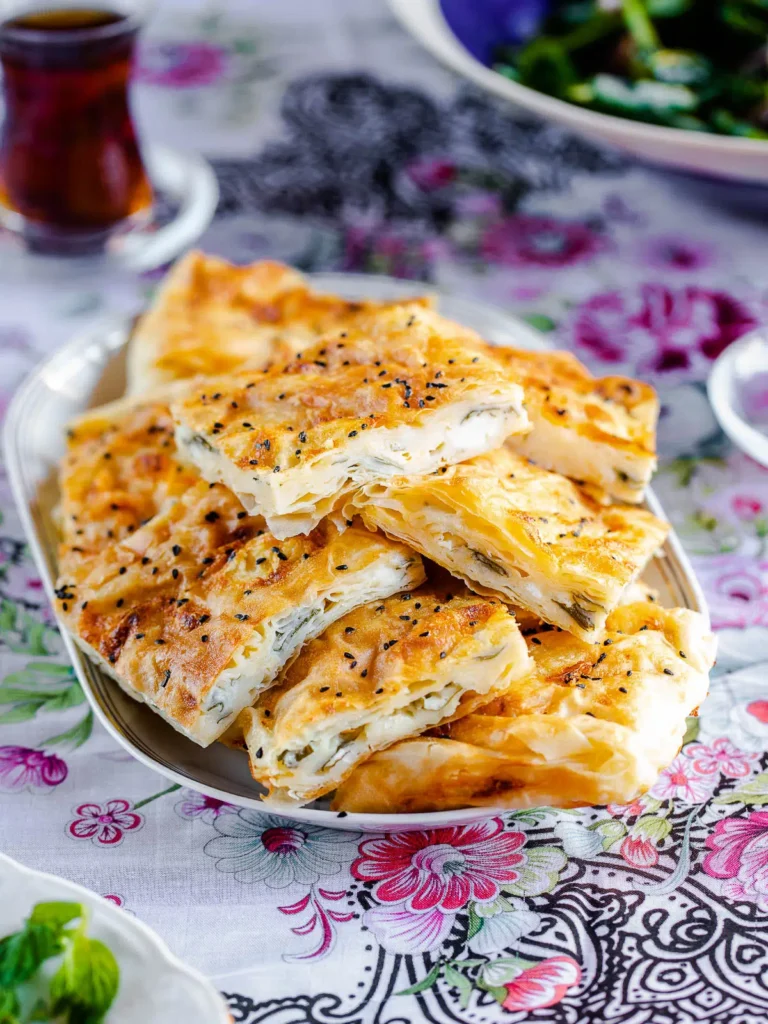
8) Börek
Börek is a savory pastry that’s a favorite in Turkish cuisine. You can fill it with various ingredients like cheese, spinach, or minced meat. The layers of yufka, which is a thin dough, make it light and flaky.
Start by keeping your yufka dough moist. Place it between two damp dish towels. This keeps the dough flexible and easy to work with.
Next, prepare your filling. You can mix cheeses, such as feta, or use spinach for a vegetarian option. Minced meat is another popular choice.
Cut the yufka into desired sizes and shapes. You can make them into rolls (sigara börek) or layer them in a tray.
Brush each layer with an egg wash or oil. This helps the börek become crisp and golden brown when baked or fried. Sprinkle sesame or nigella seeds on top for extra flavor.
Bake in a preheated oven at around 350°F for about 30-35 minutes until golden. If frying, heat some oil in a pan and fry until crispy.
Once cooked, let the börek cool slightly. This helps it set and makes it easier to cut or serve. Serve warm and enjoy the layers of crunchy, flavorful pastry.
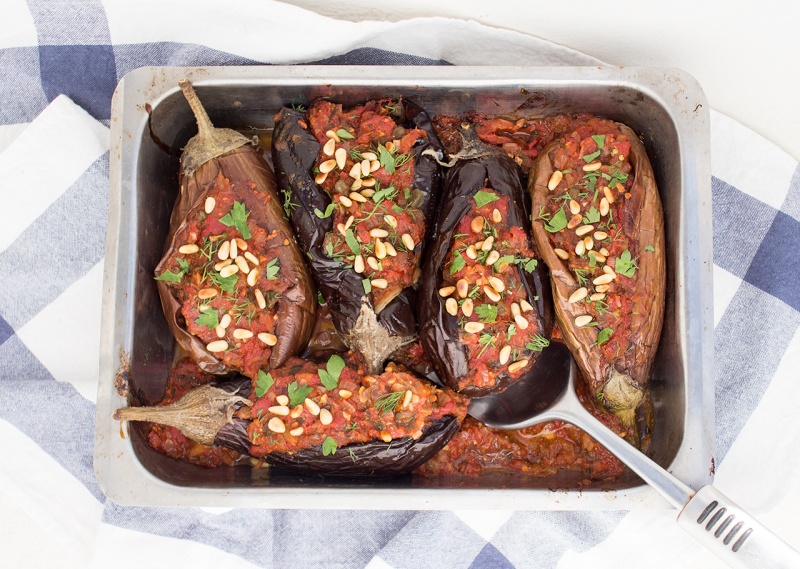
9) İmam Bayıldı
İmam Bayıldı is a classic Turkish dish that features stuffed eggplants. This recipe is ideal for a satisfying and flavorful meal.
First, you need medium-sized eggplants. Peel strips off the skin, leaving patches of skin. This helps the eggplants hold their shape while cooking.
Cut a slit lengthwise along each eggplant, but don’t cut all the way through.
Next, prepare the filling. Sauté sliced onions, chopped tomatoes, and garlic in olive oil. Add salt, pepper, and spices like cumin and paprika. Cook until the onions are soft and translucent.
Stuff the eggplants with the filling. Place them in a baking dish, and mix tomato paste with water to pour over the top.
Cover the dish with foil and bake at 180°C (350°F) for about an hour. This process makes the eggplants tender and flavorful.
After baking, let the dish rest for a few minutes before serving. İmam Bayıldı is best enjoyed at room temperature as a part of a meze platter or as a main course.
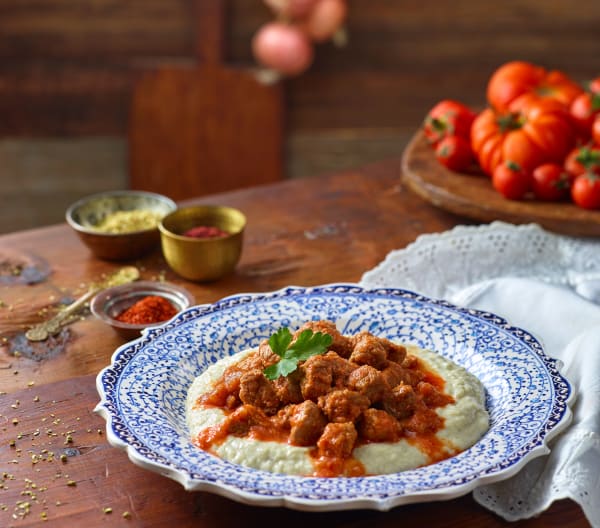
10) Hünkar Beğendi
Hünkar Beğendi, also known as “Sultan’s Delight,” is a cherished dish in Turkish cuisine. It’s a flavorful combination of creamy roasted eggplant puree and succulent lamb stew.
Begin by roasting eggplants. Prick them with a knife and bake until soft. Peel and mash the roasted eggplants. This becomes the base for the creamy puree.
For the lamb stew, start by browning lamb pieces in olive oil. Add onions, garlic, and tomato paste. Stir in spices like thyme and oregano. Pour in the stock and let it simmer until the lamb is tender.
While the lamb cooks, prepare the eggplant puree. Mix the mashed eggplants with milk, butter, and flour. Cook until smooth and creamy.
To serve, ladle the lamb stew over a generous portion of the eggplant puree. The rich, flavorful stew pairs perfectly with the creamy, smoky eggplant.
Enjoy this dish as a main course, often accompanied by rice or bread. Hünkar Beğendi showcases the rich flavors and culinary traditions of Turkey.
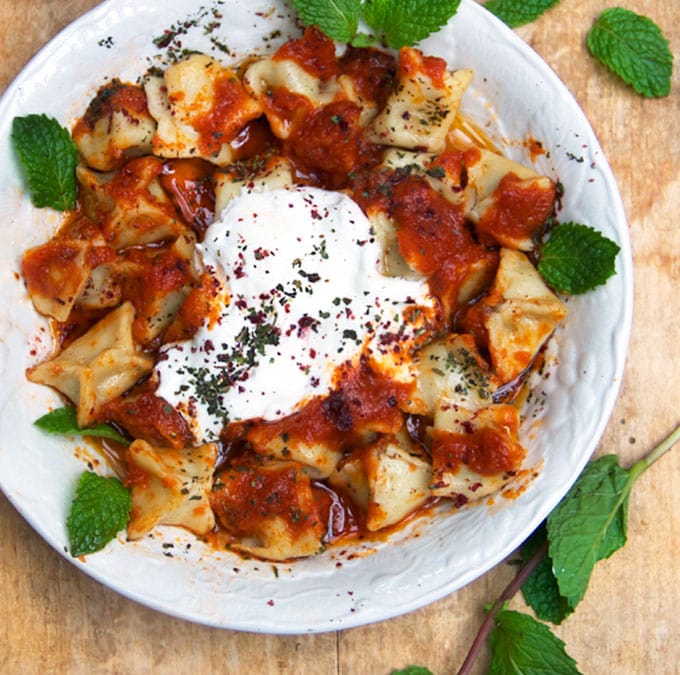
11) Manti
Manti are traditional Turkish dumplings filled with ground meat, usually lamb or beef. They are tiny and often topped with yogurt sauce and melted butter with spices.
To prepare the dough, mix flour, water, salt, and eggs. Knead the dough until smooth and let it rest. This helps the dough become easier to roll out.
For the filling, combine ground meat, finely chopped onions, salt, and pepper. Some recipes add parsley for extra flavor. Mix well until it forms a paste-like consistency.
Roll out the dough thinly on a floured surface. Cut it into small squares. Place a small amount of filling in the center of each square.
Fold the edges of the dough from the corners inward, pinching the edges to seal and form a small pouch. Repeat until all dough and filling are used.
Cook the manti by boiling them in salted water until they float. This indicates they are cooked through.
For the yogurt sauce, mix yogurt, garlic, and a bit of water. Melt butter in a pan and add red pepper flakes for the topping.
Serve the manti topped with the yogurt sauce and drizzled with the spiced butter. Enjoy your flavorful Turkish dumplings!
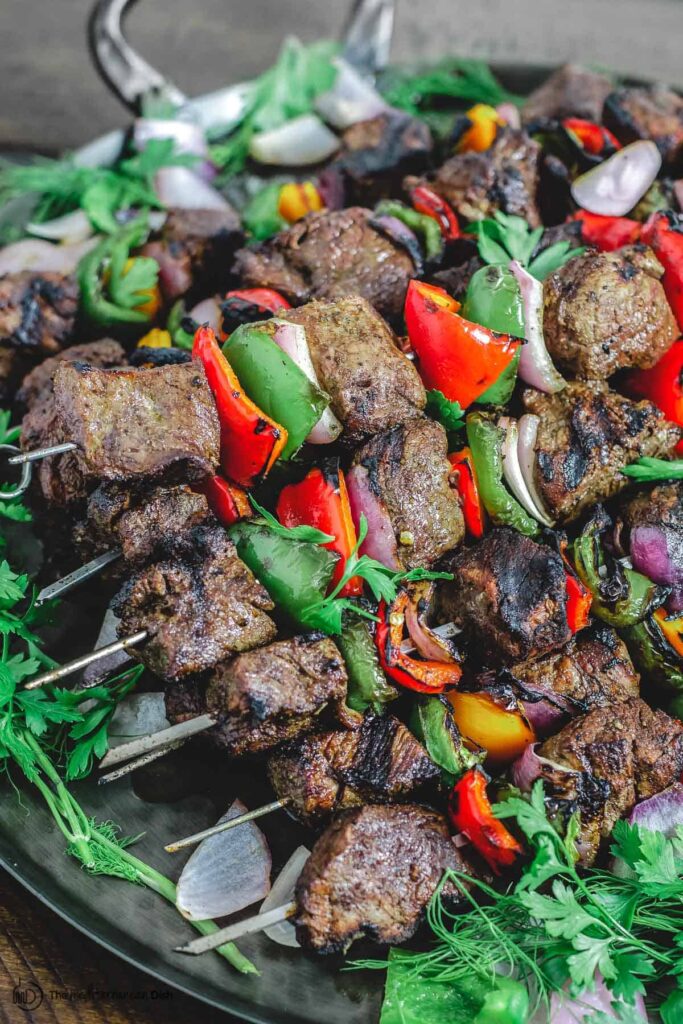
12) Şiş Kebap
Şiş Kebap is a popular Turkish dish made with marinated meat, usually chicken or lamb, skewered and grilled. This dish is known for its rich and savory flavors, thanks to the blend of spices used in the marinade.
To make chicken Şiş Kebap, start by cutting the chicken into 1-2 inch cubes. Marinate the chicken with ingredients like yogurt, olive oil, tomato paste, black pepper, paprika, and salt. Let it sit for at least an hour, or overnight for deeper flavor.
For lamb Şiş Kebap, you can use a marinade of olive oil, garlic, lemon juice, cumin, paprika, and salt. Like with chicken, cut the lamb into uniform cubes and let it marinate for optimal taste.
Once marinated, thread the meat onto skewers. Heat your grill to medium-high and cook the kebabs for about 10-12 minutes, turning occasionally to ensure even cooking and a good char.
Serve Şiş Kebap with grilled vegetables or flatbread, along with side dishes like meze plates and dips. This dish is perfect for gatherings and brings a taste of traditional Turkish cuisine to your table.
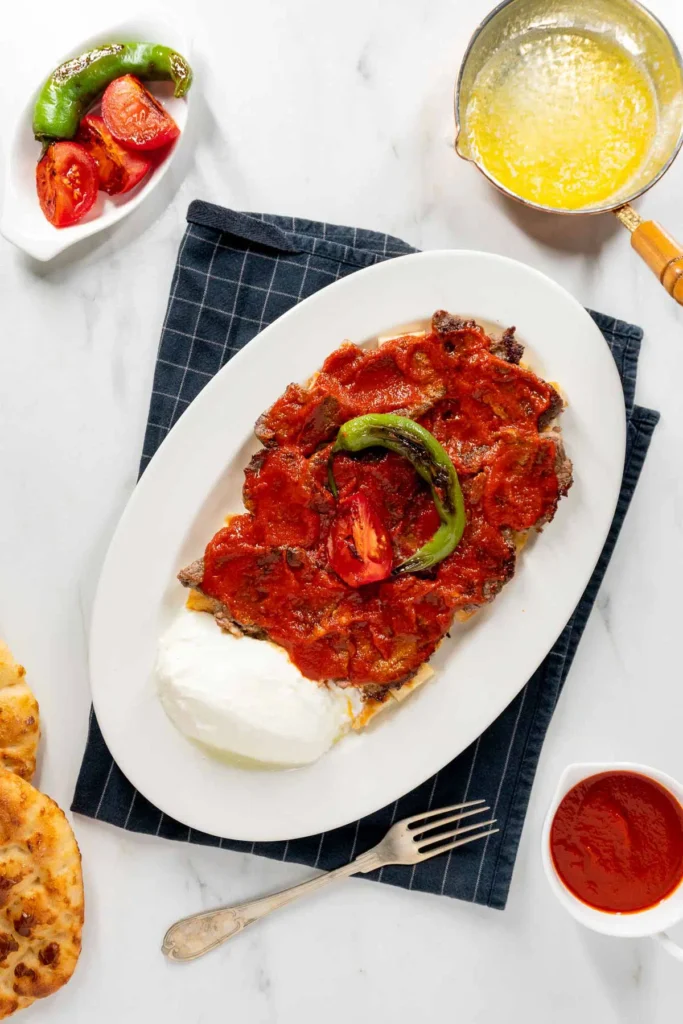
13) Iskender Kebab
Iskender Kebab is a classic Turkish dish named after its inventor, Iskender Efendi. This meal is known for its rich flavors and satisfying ingredients.
To make Iskender Kebab, you start with marinated meat. Choose rib eye steak, lamb, or beef tenderloin. Grate onions and mix with olive oil and dried oregano to make the marinade.
Cook the meat on a skewer, similar to a doner kebab. Once cooked, slice the meat thinly.
Next, prepare the tomato sauce. Heat olive oil in a saucepan and add chopped tomatoes. Stir for a few minutes before adding garlic, chili flakes, salt, and pepper. Let the sauce simmer until the tomatoes soften. Add tomato paste and a bit of water.
For the base, use pita bread. Lightly bake the bread until it’s warm and slightly crispy.
Place the sliced meat over the pita bread. Drizzle the hot tomato sauce over the top. Add a dollop of thick yogurt on the side. Include grilled tomatoes and peppers for extra flavor.
Before serving, melt some butter and drizzle it over the Iskender Kebab. This final touch adds a delicious richness to the dish. Enjoy!
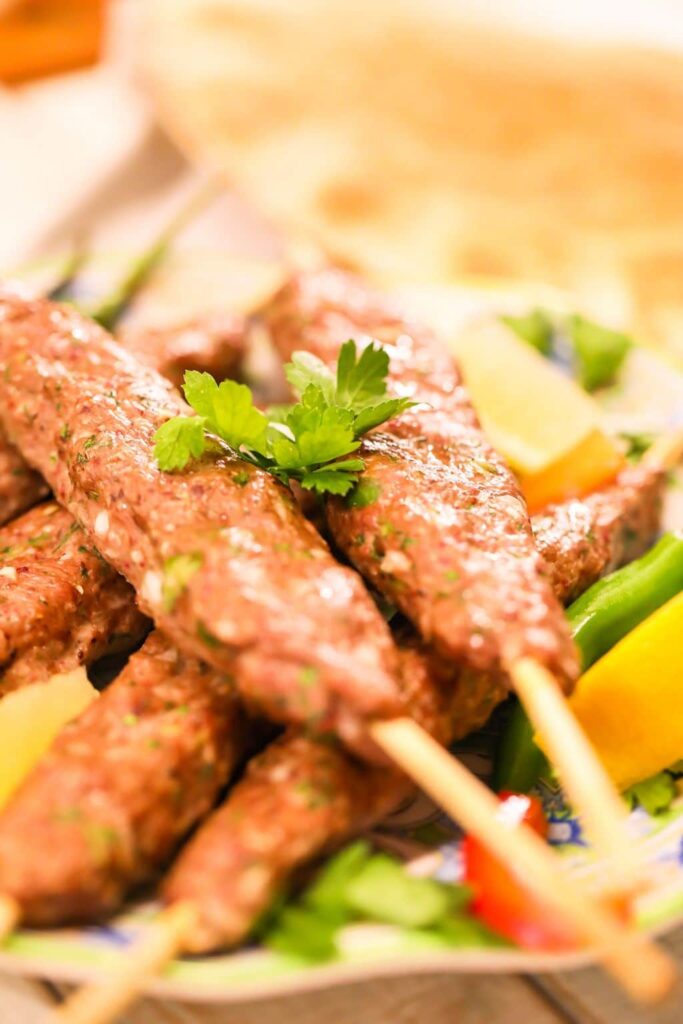
14) Adana Kebab
Adana Kebab is a traditional Turkish dish made from ground lamb. It originates from the city of Adana in southern Turkey. You will often find it served during special occasions or at Turkish restaurants.
To make Adana Kebab, you combine ground lamb with spices such as cumin, sumac, and pepper flakes. Sometimes, minced onion and garlic are added to enhance the flavor. The mixture must be kneaded well to ensure it sticks together.
Once the meat mixture is ready, you shape it onto skewers. Wet your hands to make this process easier. The kebabs are then grilled, often on a charcoal grill, until they are properly cooked.
Adana Kebab is typically served with rice, vegetables, or flatbreads. Grilled peppers can be added as a side. This dish is a favorite for its rich and spicy taste.
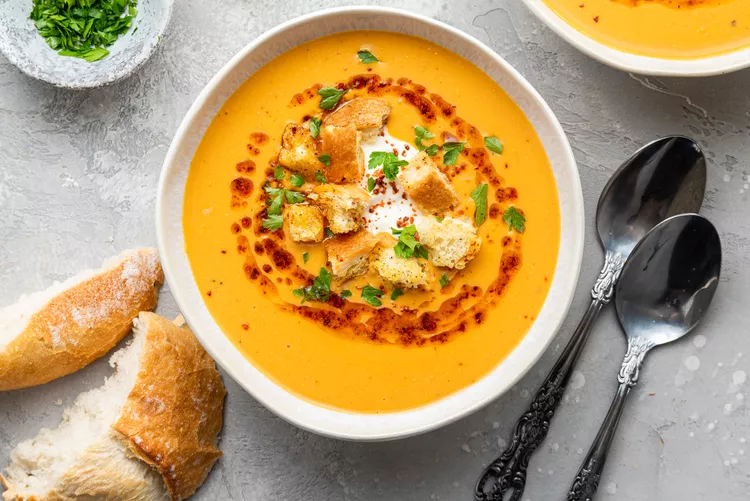
15) Mercimek Çorbası
Mercimek Çorbası, or Turkish Lentil Soup, is a staple in Turkish cuisine. It’s hearty, nutritious, and relatively easy to prepare.
To start, you’ll need red lentils, a key ingredient. Red lentils cook quickly and break down easily, which means your soup will have a creamy texture without needing any cream.
You’ll also need some basic vegetables like onions and carrots. Dice them finely so they cook evenly. Sauté these in a pot with some olive oil until they soften.
Next, you’ll add your spices. Cumin, paprika, and a touch of Aleppo pepper give the soup its distinctive flavor. Add these spices to the pot and stir well.
Then, add the red lentils and vegetable or chicken stock. Stir everything together. Let the soup come to a boil, then reduce the heat and let it simmer. This allows the flavors to meld together.
Cook the soup for about 20 minutes, or until the lentils and vegetables are tender. If you prefer a smoother texture, you can blend the soup using an immersion blender or a regular blender.
Finally, season with salt and pepper to taste. Serve your Mercimek Çorbası hot, garnished with a sprinkle of dried mint or a squeeze of lemon juice. Enjoy!
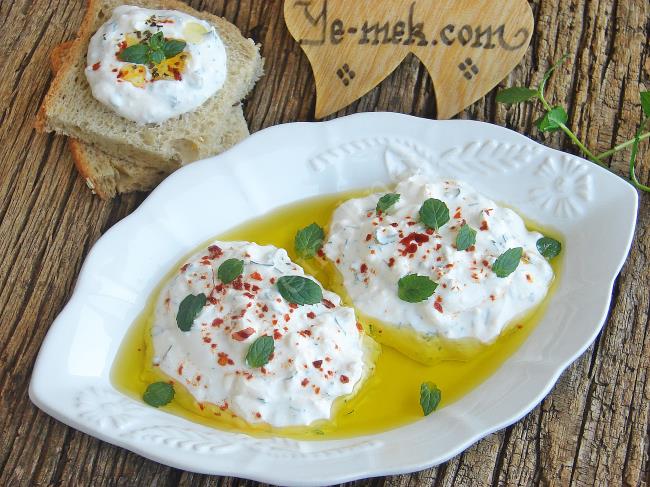
16) Süzme Yoğurt
Süzme Yoğurt, also known as Turkish strained yogurt, is a thicker version of regular yogurt. It’s made by draining the whey from plain yogurt. This creates a creamy texture and a more concentrated flavor.
Making Süzme Yoğurt at home is simple. Start by placing plain yogurt in a cloth or mesh strainer. Let it sit for several hours, allowing the excess liquid to drip away.
You can use Süzme Yoğurt in many dishes. It’s great for dips, spreading on bread, or adding to sauces. It pairs well with fresh fruits or a drizzle of honey for a healthy snack.
In Turkey, Süzme Yoğurt is often served with savory dishes too. It’s common to see it alongside grilled meats, mixed into dishes like cacık, or topping stuffed vegetables.
Its smooth texture and rich taste make it versatile in cooking. You can even incorporate it into desserts for a creamy addition without extra sweetness.
Whether you use it in traditional Turkish recipes or as a substitute for sour cream, Süzme Yoğurt is a delicious and nutritious option to have in your kitchen.
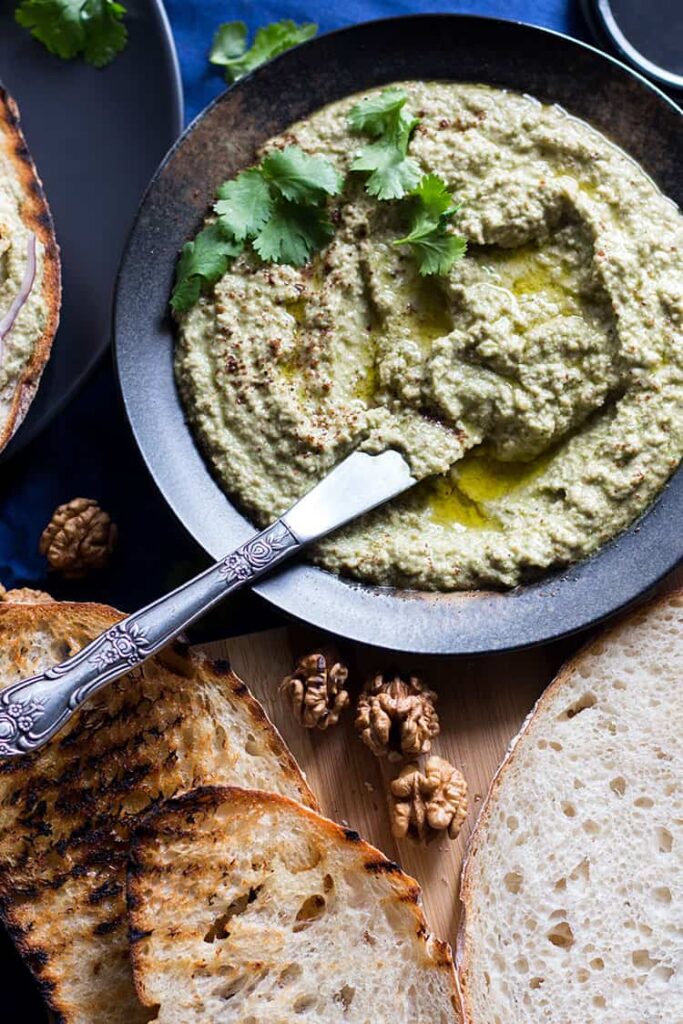
17) Tarator
Tarator is a popular dish in Turkish cuisine, often enjoyed as an appetizer or side dish. It’s a refreshing blend of vegetables, yogurt, and sometimes nuts or herbs.
One version of Tarator uses sautéed purple cabbage. The cabbage is cooked with olive oil until tender. Then, it’s mixed with yogurt and fresh lemon juice. Dill is often sprinkled on top before serving.
Another variation features carrots. Grated carrots are sautéed with garlic and sometimes walnuts. Once cooled, they’re mixed with yogurt and salt. This adds a sweet and creamy flavor to the dish.
Tarator is versatile and can be served cold. It pairs well with many Turkish meals, adding both texture and flavor. Whether made with cabbage or carrots, it’s a simple yet delicious addition to any table.
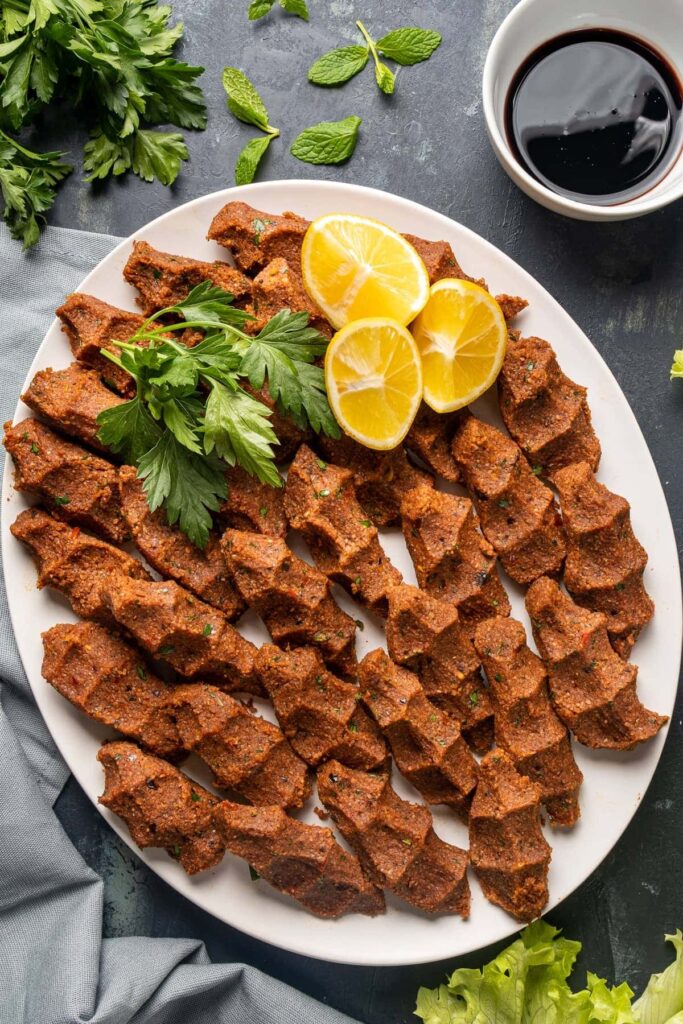
18) Çiğ Köfte
Çiğ Köfte is a traditional Turkish dish known for its unique flavor and texture. It is commonly made using fine bulgur as the base.
You’ll start by soaking the fine bulgur in water for about 10-15 minutes. This allows the bulgur to soften and absorb the water.
In a large bowl, mix the softened bulgur with tomato paste, pepper paste, and red pepper flakes. You can also add black pepper, cumin, sumac, allspice, pureed tomato, onion, and garlic.
Knead the mixture using your palms for about 10-20 minutes. This helps to blend the flavors and soften the bulgur even more.
For extra flavor, you can add pomegranate molasses, lemon juice, and finely chopped spring onions, and parsley leaves. Continue kneading for another 10 minutes.
Some recipes suggest adding minced meat, but this is optional. If you prefer a vegetarian version, you can skip this step.
Shape the mixture into small patties or bite-sized pieces. Serve chilled and enjoy your homemade Çiğ Köfte!
Çiğ Köfte is often enjoyed as a healthy snack or appetizer. Its spicy and tangy taste makes it a popular choice among Turkish dishes.
19) Niecierza
Niecierza is a traditional Turkish dish that is often made from simple, fresh ingredients. This recipe is known for its vibrant flavors and pleasing texture.
You start by preparing a mixture of lentils and rice. Cook them together until they form a soft, mushy base.
Then, you add caramelized onions. They bring sweetness and depth to the dish.
Next, season the mixture with spices like cumin and paprika. This adds a warm, smoky flavor. You can also include some garlic for an extra kick.
For a fresh touch, chop some parsley finely and sprinkle it on top. It adds color and a hint of freshness.
Niecierza is usually served with a side of yogurt. This balances the richness and adds a creamy texture.
Enjoy Niecierza warm, and consider pairing it with a simple salad. This makes for a full, satisfying meal that captures the essence of Turkish cuisine.
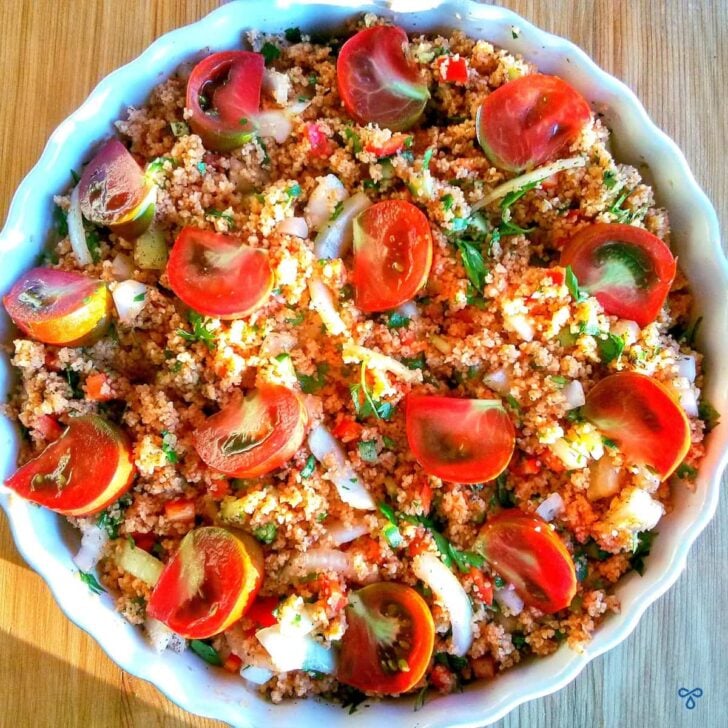
20) Kısır
Kısır is a popular Turkish bulgur salad that is both easy to make and delicious. The key ingredient is fine bulgur, which does not need cooking, only soaking in hot water.
To start, pour boiling water over the bulgur in a large bowl. Cover it and let it soak for about 15 minutes.
Once the bulgur is soft and fluffy, mix in tomato paste, pepper paste, and olive oil. These ingredients give the salad its rich, tangy flavor.
Add fresh vegetables like tomatoes, cucumbers, and green onions. Parsley and dill are often used to add freshness and a burst of color.
Season the salad with lemon juice, which adds a zesty kick. You may also include pomegranate molasses for a touch of sweetness.
Typical spices include cumin and red pepper flakes, which give the salad a warm, slightly spicy flavor.
Serve Kısır cold or at room temperature. It’s a great side dish for any meal or can be enjoyed on its own as a light and healthy lunch.
Remember, the charm of Kısır lies in its simplicity and the fresh, quality ingredients.
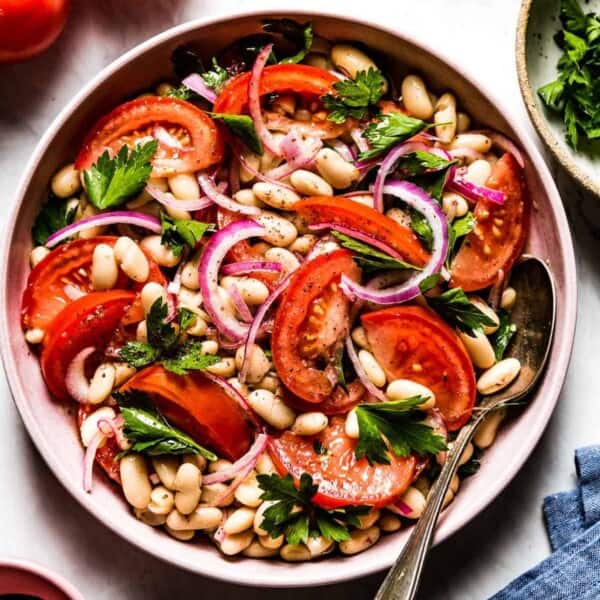
21) Piyaz
Piyaz is a traditional Turkish white bean salad. It’s a refreshing and healthy choice that works well as a side dish or even on its own.
You will need navy beans or cannellini beans for this dish. These beans are rich in protein and fiber, making the salad both nutritious and filling.
Start by preparing the beans. If you use dried beans, soak them overnight and cook until tender. If you prefer a quicker option, canned beans work too. Just make sure to drain and rinse them well.
Next, chop tomatoes, red onions, and fresh parsley. The tomatoes add juiciness, while the onions give a mild bite. Fresh parsley adds a vibrant color and fresh taste to the salad.
For an authentic touch, toss the salad with sumac. This spice is often used in Turkish cuisine and provides a tangy, lemony flavor that brightens up the dish.
Finally, dress with a simple mixture of olive oil and lemon juice. This dressing adds a light, zesty finish.
Serve your Piyaz with Turkish dishes like meatballs or stuffed eggplant. It’s a versatile salad that’s quick to prepare and delicious to eat. Enjoy this healthy, flavorful dish.
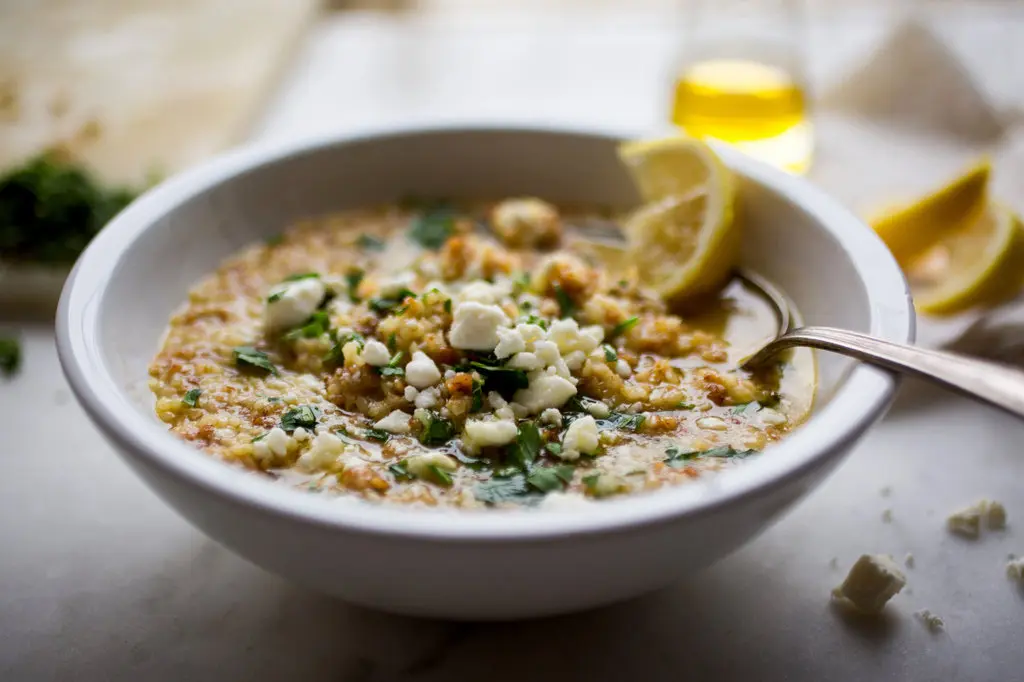
22) Tarhana Soup
Tarhana Soup is a traditional Turkish dish that offers comfort and rich flavor. It’s made from tarhana, a dried mixture of yogurt, flour, and fermented vegetables and spices.
Start by soaking the tarhana in lukewarm water for a couple of hours to rehydrate it. This step ensures the soup achieves its rich texture.
In a large pot, melt some butter or heat olive oil over medium heat. Add tomato paste and stir for about a minute. This base will give your soup a lovely depth of flavor.
Next, pour in some broth and bring it to a gentle boil. Gradually whisk in the rehydrated tarhana, making sure to dissolve any lumps. Continue to stir as you add the remaining ingredients to ensure an even texture.
Let the soup simmer on low heat to develop its full flavor. You can season it with paprika, dried mint, and salt according to your taste. This combination of spices elevates the soup, giving it a distinctive Turkish taste.
Serve your Tarhana Soup hot, optionally garnished with extra mint or a squeeze of lemon for added freshness. It’s a warming dish perfect for any time of year.
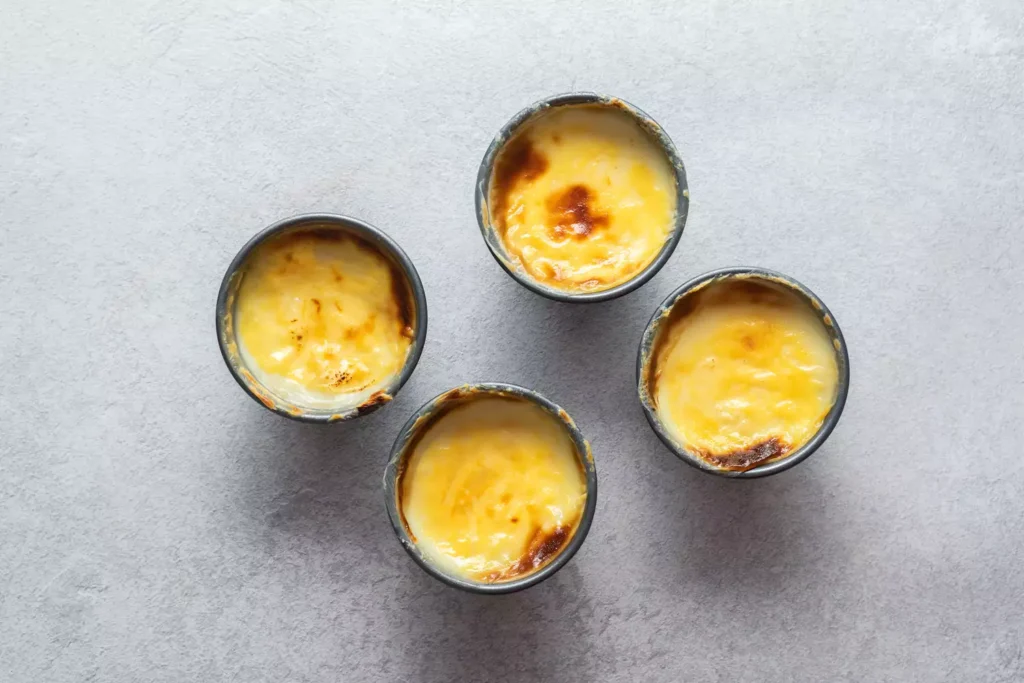
23) Fırın Sütlaç
Fırın Sütlaç is a traditional Turkish rice pudding that is baked in the oven. It has a creamy texture and a caramelized top that sets it apart from other rice puddings.
Start by rinsing your rice well to remove excess starch. In a saucepan, combine rice and water. Bring the water to a boil, then reduce heat and simmer until the rice absorbs the water and becomes tender.
Next, add milk to the saucepan with the cooked rice. Stir frequently and keep the heat low to prevent sticking. Mix cornstarch with a bit of cold milk until smooth, and then add it to the rice mixture. This will help thicken your sütlaç.
Add sugar and vanilla to the mixture, stirring constantly until well combined. You want the mixture to be thick but not too thick.
Pour the rice mixture into individual oven-safe dishes. Place the dishes in a larger baking pan filled with water, creating a water bath. This ensures even cooking and prevents the pudding from drying out.
Bake in a preheated oven at 350°F (180°C) until the tops are browned and caramelized, around 15-20 minutes. Let the Fırın Sütlaç cool to room temperature before serving. Enjoy your rich and creamy Turkish dessert!

24) Şekerpare
Şekerpare is a traditional Turkish dessert made with semolina and soaked in sweet syrup.
To make the dough, start by preheating your oven to 180°C (350°F). Combine flour, semolina, softened butter, egg, egg white, icing sugar, vanilla, and baking powder in a large mixing bowl. Mix well until the dough is smooth.
Roll about 30 grams of dough into a ball. Flatten it slightly and shape it into an oval. Place it on a baking tray lined with parchment paper. Repeat with the remaining dough.
Brush the tops of the Şekerpare with egg yolk. Use the back of a fork to create light indents on each piece.
Bake in the oven for about 20-25 minutes until golden brown.
While the cookies are baking, prepare the syrup. Boil sugar, water, and a slice of lemon in a saucepan. Let it simmer for about 10 minutes until slightly thickened.
Once the cookies are baked, allow them to cool slightly. Then, pour the warm syrup over the cookies. Let them soak until they absorb the syrup. Serve when cooled.
Enjoy Şekerpare as a delightful, sweet treat after a meal.
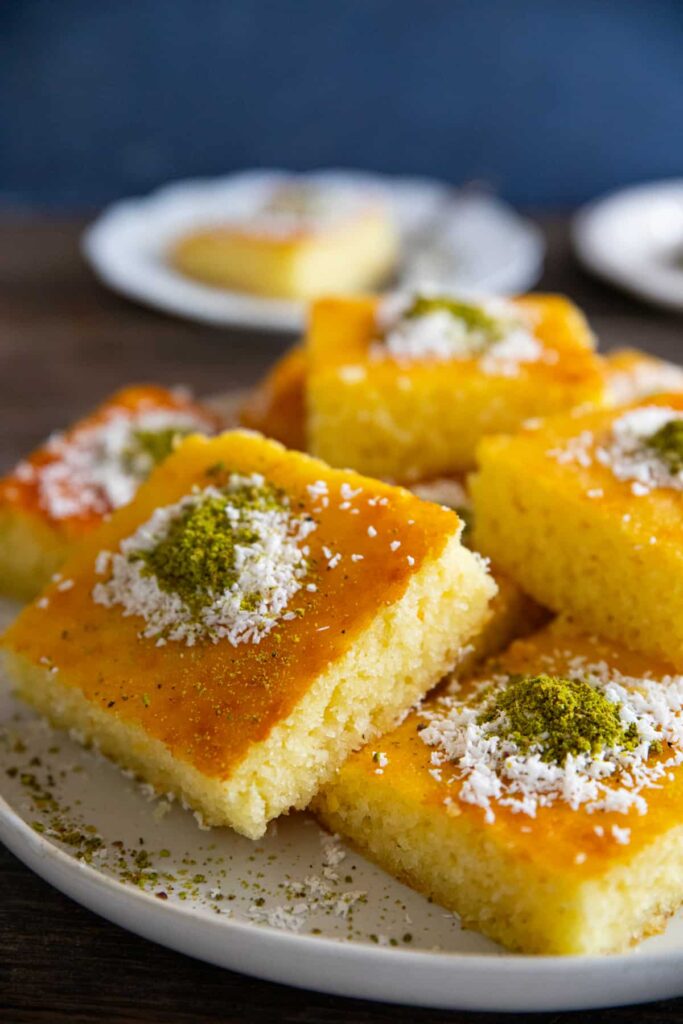
25) Revani
Revani is a delicious Turkish semolina cake soaked in syrup. It’s a favorite in Turkish households and often served during special occasions.
To make Revani, start by separating the yolks and whites of eight eggs. Beat the egg yolks with sugar and lemon zest until creamy.
Next, whisk the egg whites until they form stiff peaks. Gently fold the egg whites into the yolk mixture.
Add semolina, flour, baking powder, and a pinch of salt to the mixture. Pour the batter into a greased baking pan and bake at 350°F for about 30 minutes.
While the cake bakes, prepare the syrup. Combine sugar and water in a pan, bring it to a boil, and let it simmer. Once it reaches a syrupy consistency, add lemon juice and let it cool.
Once the cake is baked, let it cool for a few minutes. Pour the cooled syrup evenly over the cake, making sure it soaks through.
Revani is best served when it has fully absorbed the syrup. You can garnish it with shredded coconut or chopped nuts before serving. Enjoy this sweet and moist cake with your favorite tea or coffee.
Traditional Ingredients
Turkish cuisine is known for its rich flavors and diverse ingredients. Key components include a variety of spices and herbs, staple proteins like lamb and chicken, and plentiful vegetables and legumes.
Spices and Herbs
Spices and herbs are essential in Turkish cooking. Commonly used ones include cumin, paprika, and black pepper. You’ll also find coriander, cinnamon, and saffron adding depth to many dishes.
Fresh herbs like mint, parsley, and dill are often used to garnish or mix into meals. Sumac, a tangy, red spice, is sprinkled on salads and meats. Bahārāt is a notable spice blend that includes pepper, cumin, cloves, cardamom, and nutmeg. These spices create the distinct, flavorful profiles Turkish cuisine is known for.
Staple Proteins
Lamb and chicken are main proteins in Turkish dishes. You’ll often encounter them in kebabs, stews, and casseroles. Lamb is especially popular and can be prepared in various ways – grilled, roasted, or braised. Chicken is versatile, used in dishes like şiş kebabs and stews.
Seafood also features prominently, particularly in coastal regions. Fish, like sea bass and mackerel, is usually grilled or baked with simple seasonings. Dairy proteins, such as yogurt and cheese (like feta and beyaz peynir), are used in many mezes and side dishes to add richness and texture.
Vegetables and Legumes
Vegetables and legumes are central to Turkish cooking. Tomatoes, eggplants, and bell peppers are frequently used in stews, salads, and mezes. They are often stuffed with rice or meat, creating dishes like dolma.
Legumes, such as lentils and chickpeas, are staples in soups and salads. Lentil soup and chickpea stew are hearty and nutritious options. Fresh, crisp vegetables like cucumbers and carrots are common in salads. Herbs like parsley and dill add freshness to these vegetable dishes, enhancing their natural flavors.
This blend of diverse ingredients helps make Turkish cuisine vibrant and delicious.
Cooking Techniques
Traditional Turkish cuisine uses a range of cooking techniques to enhance the flavors of fresh ingredients. From slow-cooked stews to perfectly grilled meats, each method brings out the unique taste and texture of the dish.
Braising and Stewing
Braising and stewing are essential methods in Turkish cooking, especially for meat and vegetable dishes. Slow-cooked meals like guvec and etli taze fasulye require patience and care. The process often begins by searing the ingredients, which locks in flavors.
Braising Tips:
- Use a heavy pot with a lid.
- Sear meats until browned on all sides.
- Add liquid such as broth, water, or wine.
- Cook on low heat for several hours.
Stewing Essentials:
- Combine ingredients in a pot.
- Add enough liquid to cover.
- Simmer for a long period, stirring occasionally.
- Use fresh herbs and spices for extra depth.
Grilling and Roasting
Grilling and roasting are popular techniques in Turkish cuisine, giving dishes a smoky and rich flavor. Kebab is a famous grilled dish, while tavuk göğsü (roasted chicken) showcases the roasting method.
Grilling Techniques:
- Marinate meats beforehand to enhance flavor.
- Preheat the grill to a medium-high temperature.
- Grill meats evenly, turning frequently.
- Use skewers for kebabs to ensure even cooking.
Roasting Techniques:
- Preheat the oven to the desired temperature.
- Season meats and vegetables with spices and herbs.
- Roast on a baking sheet or in a roasting pan.
- Baste occasionally with juices to keep it moist.
Sauce Preparation
Sauces play a key role in many Turkish recipes, adding depth and complexity to the dishes. From the tangy cacik to the spicy biber salçası, making these sauces requires both precision and creativity.
Basic Sauce Tips:
- Use fresh ingredients like yogurt, garlic, and cucumbers.
- Blend or mix until smooth.
- Cook over low heat for thicker sauces.
- Adjust seasonings according to taste.
Popular Turkish Sauces:
- Cacik: Made with yogurt, cucumber, garlic, and dried mint.
- Biber Salçası: Pepper paste used in various dishes.
- Tahini Sauce: Blend of tahini, lemon juice, garlic, and water.
Health Benefits and Nutrition
Turkish cuisine is not only delicious but also packed with numerous health benefits. The dishes incorporate a mix of proteins, healthy fats, and essential nutrients, making them an excellent choice for balanced meals.
Nutritional Values
Turkish recipes often feature a variety of ingredients that provide a balanced nutritional profile. Proteins such as lamb, chicken, and chickpeas are frequently used, offering essential amino acids. Vegetables such as eggplant, tomatoes, and bell peppers provide vitamins A and C, and dietary fiber.
Foods like olive oil are a common component, known for their healthy fats including monounsaturated fats, which support heart health. Grains like bulgur and rice add carbohydrates that supply energy. By using herbs and spices like sumac and cumin, Turkish dishes often reduce the need for excess salt while still being full of flavor.
Health Benefits of Common Ingredients
Eggplant: Rich in antioxidants and dietary fiber, eggplant supports digestive health and reduces inflammation.
Yogurt: High in probiotics and calcium, yogurt promotes gut health and strengthens bones.
Chickpeas: Packed with protein, fiber, and iron, chickpeas help in muscle repair and support a healthy immune system.
Olive Oil: Contains monounsaturated fats that support heart health and reduce bad cholesterol levels.
Tomatoes: These are rich in vitamins C and K and the antioxidant lycopene, which may reduce the risk of certain cancers and heart diseases.
Other spices and herbs used regularly, like mint, parsley, and dill, provide additional antioxidants and nutrients, adding both health benefits and flavor to the dishes.
